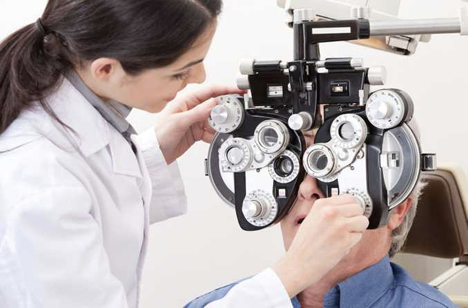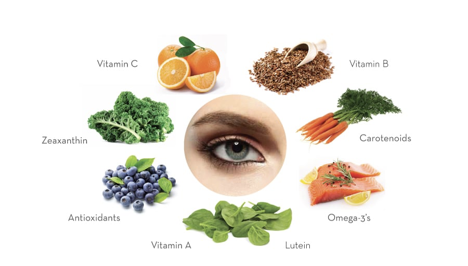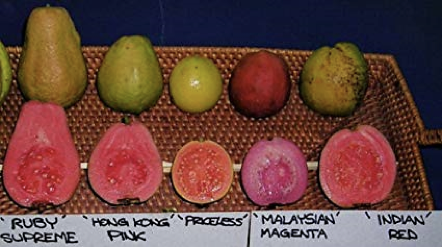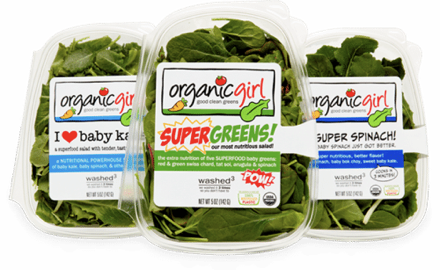The "Eyes" Have It! (Or at least they ought to!)
By 2020 (oops, here we are!), the population of adults with vision impairment and age-related eye diseases is going to be frightening (so says the CDC) due to the rapidly aging U.S. population and decades of poor diet and resultant diseases. In addition, the epidemic of diabetes as well as other chronic diseases will continue to contribute to a surge in vision loss.
But according to boatloads of research and doctor after doctor, we can do something about this trend. Besides wearing good sunglasses, having regular eye exams, and wearing protective glasses when needed, the biggie is eating well. No surprises there, right? Good eye health starts with the food on your plate.

Nutrients like omega-3 fatty acids, lutein, zinc, and vitamins C and E are proven to ward off age-related vision problems like macular degeneration and cataracts. To get these nutrients, fill your plate with:

It’s all about healthy antioxidants. A diet full of specific antioxidants and minerals can significantly benefit the health of our eyes. Since we have blood sugar issues and full blown diabetes on both sides of our family, and since I need a pretty high vision prescription, I’m interested in this aspect of nutrition. Here’s what more food-specific research shows:
The guava is considered a super-fruit for its exceptional nutrient richness, antioxidant quality and taste. It’s bursting with vitamin C (a half cup serving offers 188 mg), knocking off the traditional vitamin C “king,” the orange (which only packs 53 mg). It’s recommended we get at least 500 mg of vitamin C daily, so the guava is a tasty and efficient help in this direction. And it also contains carotenoids, folate, potassium, calcium and iron. (Note: Research also links vitamin C to the prevention of cataracts and eye-pressure reduction in glaucoma patients.)

And then there are the super-greens: kale, spinach, Swiss chard, watercress and beet greens. They boast the highest natural combination of the carotenoid antioxidants lutein and zeaxanthin (26.5 mg per cup). Lutein, the primary carotenoid located in the retina, filters out harmful UVB light and threatening free radicals. Studies recommend 6 mg of lutein daily, which reduces the risk of AMD (age-related macular degeneration) by nearly 57%. Doctors feel it is by far the number one nutritional treatment for AMD. These greens also offer vitamins A, B6, C, E, and K, beta-carotene, fiber, protein, calcium, potassium, and folate. I vote for super greens!

Finally, the beautiful sweet bell peppers. Is this a gorgeous food, or what! The red bell pepper, especially, ranks as one of the highest plant sources of vitamin E and beta-carotene. Plus they contain lutein. All sweet peppers burst with vitamin C—around 141 mg per half cup serving. With the benefits these antioxidants provide for eye health, bell peppers are a one-stop-shop for healthier eyes.
Perhaps it’s no coincidence that the year 2020 could also relate to clearer vision! This could be the year of conscientious and deliberate eye-healthy diet. “Eye” vote for that and it looks like the “Eyes” have it!

But according to boatloads of research and doctor after doctor, we can do something about this trend. Besides wearing good sunglasses, having regular eye exams, and wearing protective glasses when needed, the biggie is eating well. No surprises there, right? Good eye health starts with the food on your plate.

Nutrients like omega-3 fatty acids, lutein, zinc, and vitamins C and E are proven to ward off age-related vision problems like macular degeneration and cataracts. To get these nutrients, fill your plate with:
- Green leafy vegetables like spinach, kale, and collards
- Salmon, tuna, and other oily fish
- Eggs, nuts, beans, and other nonmeat protein sources
- Oranges and other citrus fruits or juices
- Oysters and pork

It’s all about healthy antioxidants. A diet full of specific antioxidants and minerals can significantly benefit the health of our eyes. Since we have blood sugar issues and full blown diabetes on both sides of our family, and since I need a pretty high vision prescription, I’m interested in this aspect of nutrition. Here’s what more food-specific research shows:
The guava is considered a super-fruit for its exceptional nutrient richness, antioxidant quality and taste. It’s bursting with vitamin C (a half cup serving offers 188 mg), knocking off the traditional vitamin C “king,” the orange (which only packs 53 mg). It’s recommended we get at least 500 mg of vitamin C daily, so the guava is a tasty and efficient help in this direction. And it also contains carotenoids, folate, potassium, calcium and iron. (Note: Research also links vitamin C to the prevention of cataracts and eye-pressure reduction in glaucoma patients.)

And then there are the super-greens: kale, spinach, Swiss chard, watercress and beet greens. They boast the highest natural combination of the carotenoid antioxidants lutein and zeaxanthin (26.5 mg per cup). Lutein, the primary carotenoid located in the retina, filters out harmful UVB light and threatening free radicals. Studies recommend 6 mg of lutein daily, which reduces the risk of AMD (age-related macular degeneration) by nearly 57%. Doctors feel it is by far the number one nutritional treatment for AMD. These greens also offer vitamins A, B6, C, E, and K, beta-carotene, fiber, protein, calcium, potassium, and folate. I vote for super greens!

Finally, the beautiful sweet bell peppers. Is this a gorgeous food, or what! The red bell pepper, especially, ranks as one of the highest plant sources of vitamin E and beta-carotene. Plus they contain lutein. All sweet peppers burst with vitamin C—around 141 mg per half cup serving. With the benefits these antioxidants provide for eye health, bell peppers are a one-stop-shop for healthier eyes.
Perhaps it’s no coincidence that the year 2020 could also relate to clearer vision! This could be the year of conscientious and deliberate eye-healthy diet. “Eye” vote for that and it looks like the “Eyes” have it!

Sources:
- www.allaboutvision.com
- www.villageeyecare.net
- www.amazon.com
- www.iloveorganicgirl.com
- www.christplace.church
 Alice Osborne
Alice Osborne
Weekly Newsletter Contributor since 2006
Email the author! alice@dvo.com
